This site uses cookies as defined in our Cookie Policy, by continuing to use this site you agree to their use.
Continue
Welcome to AE Expeditions’ Traversing the Northwest Passage (formerly called Complete Northwest Passage) expedition. On this epic voyage inspired by Roald Amundsen’s historic expedition, we attempt to sail the full length of the Northwest Passage, carving our way west through the labyrinthine maze of waterways that hug the fabled islands of Arctic Canada until we reach the Beaufort Sea. Building on our classic Northwest Passage voyage, we visit historical sites explored by heroic explorers, meet the incredible folk that call this region home, and search for enigmatic wildlife found ... in this unique corner of the world. Pack ice may halt our voyage through the passage, so brace yourself for a genuine expedition where adventure awaits at every turn.
| Arrive | Depart | ||||||
| 20th20 | AugAug | 202626 | Toronto, Ontario, Canada, embark on the Greg Mortimer | ||||
| Having made your way to Toronto Airport, check-in at our group hotel located near the airport for an overnight stay. Please visit the Aurora Expeditions hospitality desk to collect your luggage cabin tags and to speak with our ground operations team, who may have information to share with you about pre-embarkation procedures and the charter flight to Nuuk tomorrow. You will receive Aurora Expeditions cabin tags for your luggage. Please clearly label the tags with your name and ship cabin number. | |||||||
| 21st21 | AugAug | 202626 | Nuuk (Godthaab), Greenland | ||||
Nuuk, meaning “the cape”, was Greenland’s first town (1728). Started as a fort and later mission and trading post some 240 kilometers south of the Arctic Circle, it is the current capital. Almost 30% of Greenland’s population lives in the town. Not only does Nuuk have great natural beauty in its vicinity, but there are Inuit ruins, Hans Egede’s home, the parliament, and the Church of our Saviour as well. The Greenlandic National Museum has an outstanding collection of Greenlandic traditional dresses, as well as the famous Qilakitsoq mummies. The Katuaq Cultural Center’s building was inspired by the undulating Northern Lights and can house 10% of Nuuk’s inhabitants. After breakfast at the hotel, board our charter flight to Nuuk, Greenland, where our vessel Sylvia Earle awaits. After boarding, there is time to settle into your cabin before our important safety briefings. This evening, meet your expedition team and crew at the Captain’s Welcome Drinks. | |||||||
| 22nd22 | AugAug | 202626 | Sisimiut (Holsteinsborg), Greenland | ||||
Located just north of the Arctic Circle, Sisimiut is the northernmost town in Greenland where the port remains free of ice in the winter. Yet it is also the southernmost town where there is enough snow and ice to drive a dogsled in winter and spring. In Sisimiut, travelling by sled has been the primary means of winter transportation for centuries. In fact, the area has been inhabited for approximately 4,500 years. Modern Sisimiut is the largest business center in the north of Greenland, and is one of the fastest growing Greenlandic cities. Commercial fishing is the lead economy in the town‘s thriving industrial base. Greenland’s second largest town, Sisimiut is located approximately 54 kilometres (33.5 miles) north of the Arctic Circle, meaning that during summer, you can experience the midnight sun here. The town is famous for the old blue church with the gate made of whale bone. In the cosy museum next door to the church, you will find an excellent reconstruction of an Inuit turf house as well as exhibits of local history and early life in Greenland. Approximately 4,500 years ago, the Saqqaq culture arrived from Canada and settled in the area. They lived here for approximately 2,000 years, after which they mysteriously disappeared from the area. The Dorset culture arrived around 500 CE and stayed until the 1200s until they were replaced by the Thule culture, and today, most of the population of Sisimiut are descendants of the Thule culture. | |||||||
| 23rd23 | AugAug | 202626 | Ilulissat (Jakobshavn), Greenland | ||||
Known as the birthplace of icebergs, the Ilulissat Icefjord produces nearly 20 million tons of ice each day. In fact, the word Ilulissat means “icebergs” in the Kalaallisut language. The town of Ilulissat is known for its long periods of calm and settled weather, but the climate tends to be cold due to its proximity to the fjord. Approximately 4,500 people live in Ilulissat, the third-largest town in Greenland after Nuuk and Sisimiut. Some people here estimate that there are nearly as many sled dogs as human beings living in the town that also boasts a local history museum located in the former home of Greenlandic folk hero and famed polar explorer Knud Rasmussen. In the afternoon we arrive in Ilulissat. Known as the ‘birthplace of icebergs’, this region produces some of the most dazzling icebergs found anywhere in the Arctic. Hike past the husky sledge dogs to the UNESCO World Heritage-listed Icefjord and stand in awe at its immensity. Sermeq Kujalleq, also known as Jakobshavn Glacier, is the most productive glacier – not only in Greenland but the entire Northern Hemisphere. It produces 20 million tonnes of ice each day, all floating into the Ilulissat Icefjord and Disko Bay. Optional helicopter flight (90 mins): This excursion is the only way you can get close to the gigantic glacier. The 10-seater helicopter departs from Ilulissat Airport sweeping over hills, lakes and ice fjords. Land on the mountain at Kangia, in the middle of the preserved area, where you can revel in the incredible surroundings. On the return flight to Ilulissat, fly above the edge of the glacier with breathtaking views of the massive icebergs drifting in the fjord. The views of some of the largest icebergs that become stranded on a moraine underneath the water, just outside the town, offers a wonderful finale to this excursion. Please note that this is a paid excursion and requires a minimum of 8 passengers to operate and seats are strictly limited. Bookings must be made before departure and cannot be booked onboard. Cut off is usually 90 days prior. Please call reservations for pricing. | |||||||
| 24th24 | AugAug | 202626 | At Sea | ||||
| 25th25 | AugAug | 202626 | At Sea | ||||
| 26th26 | AugAug | 202626 | At Sea | ||||
| 27th27 | AugAug | 202626 | At Sea | ||||
| 28th28 | AugAug | 202626 | Pond Inlet, Nunavut, Canada | ||||
Located in northern Baffin Island, Pond Inlet is a small, predo¬minantly Inuit community, with a population of roughly 1,500 inhabitants. In 1818, the British explorer John Ross named a bay in the vicinity after the English astronomer John Pond. Today Pond Inlet is considered one of Canada's "jewels of the North" thanks to several picturesque glaciers and mountain ranges nearby. Many archaeological sites of ancient Dorset and Thule peoples can be found near Pond Inlet. The Inuit hunted caribou, ringed and harp seals, fish, polar bears, walrus, narwhals, geese, ptarmigans and Arctic hares, long before European and American whalers came here to harvest bowhead whales. Pond Inlet is also known as a major center of Inuit art, especially the printmaking and stone carving that are featured in the town’s art galleries. After clearance into Canada, we hope to visit Pond Inlet (Mittimatalik), a captivating Inuit community nestled on the northern tip of Baffin Island. Surrounded by towering ice-capped mountains, vast glaciers, and pristine fjords, this remote outpost offers an unparalleled wilderness experience. As you step ashore, you'll be greeted by the warm hospitality of the local Inuit, whose deep connection to the land is evident in their culture and lifestyle. Immerse yourself in their traditions through engaging cultural encounters and gain insights into their unique perspective on life in the Arctic. | |||||||
| 29th29 | AugAug | 202626 | Devon Island, Nunavut, Canada | ||||
Devon Island, located in Baffin Bay, is only slightly smaller than Croatia. The eastern side is frosted by the Devon Ice Cap, while on the western half of the island lays the 14 mile wide Haughton impact crater. It was created around 39 million years ago when a meteorite crashed into the land. The landscape surrounding this site resembles the surface of Mars. In fact, for the past decade scientists have conducted research here to determine how humans might live one day on Mars. British Arctic explorers Robert Bylot and William Baffin were the first Europeans to sight the island in 1616. In 1819-1820, William Parry charted the island, naming it North Devon after Devon in England. Despite repeated attempts at trading settlements, the strong wind conditions and cold climate eventually drove everyone away leaving Devon Island as a likely candidate for being the world’s largest uninhabited island. At a latitude of almost 75° degrees north, we are now truly in the High Arctic. Here, nutrient-rich waters support an abundance of wildlife, giving the area the moniker ‘wildlife superhighway’ of the Arctic. Devon Island (Tallurutit) is the largest uninhabited island on Earth and features stunning geology, with flat-topped mountains and glacial valleys giving Devon Island its unique character. We hope to visit Dundas Harbour to enjoy offers walks on undulating tundra, and perhaps some birdwatching. A dilapidated Royal Canadian Mounted Police outpost and remnants of a Hudson’s Bay Company trading post can be found here. In the bay, walruses are often present. Other possible places that we might visit include Croker Bay and Maxwell Bay. At the western end of Devon Island lies Beechey Island (Iluvilik), where we plan to land. Named after Frederick William Beechey, the island is a designated Canadian National Historic Site. During the Franklin expedition of 1845– 46, Franklin attempted to sail through the Northwest Passage with HMS Erebus and HMS Terror, with perilous results – three of his men are buried here. Roald Amundsen landed at Beechey Island in 1903, during the first successful voyage by ship to fully transit the Northwest Passage from the Atlantic Ocean to the Pacific Ocean. Just a short distance away, Radstock Bay offers a captivating contrast to the open sea. Here, we’ll disembark via Zodiac onto a beach strewn with remnants of the past. Explore the ruins of a Thule village nestled beneath the imposing Caswell Tower, where well preserved stone dwellings coexist with artifacts from later explorers. Witness the stark beauty of this remote bay, characterised by its dramatic cliffs, gravelly beaches, and the scattered remains of whale skeletons that have shaped the landscape and the lives of those who called it home. | |||||||
| 30th30 | AugAug | 202626 | Devon Island, Nunavut, Canada | ||||
Devon Island, located in Baffin Bay, is only slightly smaller than Croatia. The eastern side is frosted by the Devon Ice Cap, while on the western half of the island lays the 14 mile wide Haughton impact crater. It was created around 39 million years ago when a meteorite crashed into the land. The landscape surrounding this site resembles the surface of Mars. In fact, for the past decade scientists have conducted research here to determine how humans might live one day on Mars. British Arctic explorers Robert Bylot and William Baffin were the first Europeans to sight the island in 1616. In 1819-1820, William Parry charted the island, naming it North Devon after Devon in England. Despite repeated attempts at trading settlements, the strong wind conditions and cold climate eventually drove everyone away leaving Devon Island as a likely candidate for being the world’s largest uninhabited island. At a latitude of almost 75° degrees north, we are now truly in the High Arctic. Here, nutrient-rich waters support an abundance of wildlife, giving the area the moniker ‘wildlife superhighway’ of the Arctic. Devon Island (Tallurutit) is the largest uninhabited island on Earth and features stunning geology, with flat-topped mountains and glacial valleys giving Devon Island its unique character. We hope to visit Dundas Harbour to enjoy offers walks on undulating tundra, and perhaps some birdwatching. A dilapidated Royal Canadian Mounted Police outpost and remnants of a Hudson’s Bay Company trading post can be found here. In the bay, walruses are often present. Other possible places that we might visit include Croker Bay and Maxwell Bay. At the western end of Devon Island lies Beechey Island (Iluvilik), where we plan to land. Named after Frederick William Beechey, the island is a designated Canadian National Historic Site. During the Franklin expedition of 1845– 46, Franklin attempted to sail through the Northwest Passage with HMS Erebus and HMS Terror, with perilous results – three of his men are buried here. Roald Amundsen landed at Beechey Island in 1903, during the first successful voyage by ship to fully transit the Northwest Passage from the Atlantic Ocean to the Pacific Ocean. Just a short distance away, Radstock Bay offers a captivating contrast to the open sea. Here, we’ll disembark via Zodiac onto a beach strewn with remnants of the past. Explore the ruins of a Thule village nestled beneath the imposing Caswell Tower, where well preserved stone dwellings coexist with artifacts from later explorers. Witness the stark beauty of this remote bay, characterised by its dramatic cliffs, gravelly beaches, and the scattered remains of whale skeletons that have shaped the landscape and the lives of those who called it home. | |||||||
| 31st31 | AugAug | 202626 | Devon Island, Nunavut, Canada | ||||
Devon Island, located in Baffin Bay, is only slightly smaller than Croatia. The eastern side is frosted by the Devon Ice Cap, while on the western half of the island lays the 14 mile wide Haughton impact crater. It was created around 39 million years ago when a meteorite crashed into the land. The landscape surrounding this site resembles the surface of Mars. In fact, for the past decade scientists have conducted research here to determine how humans might live one day on Mars. British Arctic explorers Robert Bylot and William Baffin were the first Europeans to sight the island in 1616. In 1819-1820, William Parry charted the island, naming it North Devon after Devon in England. Despite repeated attempts at trading settlements, the strong wind conditions and cold climate eventually drove everyone away leaving Devon Island as a likely candidate for being the world’s largest uninhabited island. At a latitude of almost 75° degrees north, we are now truly in the High Arctic. Here, nutrient-rich waters support an abundance of wildlife, giving the area the moniker ‘wildlife superhighway’ of the Arctic. Devon Island (Tallurutit) is the largest uninhabited island on Earth and features stunning geology, with flat-topped mountains and glacial valleys giving Devon Island its unique character. We hope to visit Dundas Harbour to enjoy offers walks on undulating tundra, and perhaps some birdwatching. A dilapidated Royal Canadian Mounted Police outpost and remnants of a Hudson’s Bay Company trading post can be found here. In the bay, walruses are often present. Other possible places that we might visit include Croker Bay and Maxwell Bay. At the western end of Devon Island lies Beechey Island (Iluvilik), where we plan to land. Named after Frederick William Beechey, the island is a designated Canadian National Historic Site. During the Franklin expedition of 1845– 46, Franklin attempted to sail through the Northwest Passage with HMS Erebus and HMS Terror, with perilous results – three of his men are buried here. Roald Amundsen landed at Beechey Island in 1903, during the first successful voyage by ship to fully transit the Northwest Passage from the Atlantic Ocean to the Pacific Ocean. Just a short distance away, Radstock Bay offers a captivating contrast to the open sea. Here, we’ll disembark via Zodiac onto a beach strewn with remnants of the past. Explore the ruins of a Thule village nestled beneath the imposing Caswell Tower, where well preserved stone dwellings coexist with artifacts from later explorers. Witness the stark beauty of this remote bay, characterised by its dramatic cliffs, gravelly beaches, and the scattered remains of whale skeletons that have shaped the landscape and the lives of those who called it home. | |||||||
| 1st01 | SepSep | 202626 | At Sea | ||||
| 2nd02 | SepSep | 202626 | At Sea | ||||
| 3rd03 | SepSep | 202626 | At Sea | ||||
| 4th04 | SepSep | 202626 | At Sea | ||||
| 5th05 | SepSep | 202626 | At Sea | ||||
| 6th06 | SepSep | 202626 | Amundsen Gulf, Northwest Territories, Canada | ||||
| Your experienced expedition team will create your day-by-day itineraries based on sea ice and weather conditions. Apart from Franklin, other heroic explorers including Amundsen explored this territory, and we may visit the same places as early explorers. We hope to meet the resilient locals who make the extreme far north their home. Below are some of the places in the area that we may visit: Johansen Bay, Edinburgh Island (Egloovikan) We hope to enjoy a Zodiac excursion within an estuary of at the northeast end of Johansen Bay and up the river towards the lake. Wildlife including caribous, reindeer, arctic foxes, hares and peregrine falcons frequent the area. Nearby, Edinburgh Island (Egloovikan) is a small and uninhabited island in Canada’s Nunavut region. The scenery consists of colourful flowering shrubs, beaches tinged in stunning ochres, while the surrounding cliffs shaded in rich, deep tones. A possible walk to a lookout overlooking the lake offers spectacular views over lakes, sea and mountains. Port Epworth (Kugluktoalok) The Tree River area on the mainland — also known a Port Epworth — provides a spectacular backdrop our possible exploration, with its river and shallow lakes, striking sedimentary rock outcrops, and bright autumnal colours of tundra. This area is also known for its stromatolites – the petrified remains of ancient mounds of algae, formed some two billion years ago by the same microorganisms responsible for producing the oxygen we breathe today. Smoking Hills (Ingniryuat), Franklin Bay The Smoking Hills (Ingniryuat) in Canada’s Northwest Territories have been smouldering, sending plumes of gas across the landscape, for centuries. Technically sea cliffs, you would be forgiven for thinking that the multicoloured fiery natural phenomenon is the set to an apocalyptic movie depicting the end of the world. The smoke is caused by layers of combustible, sulphur-rich lignite (brown coal) that ignites and emit sulphurous gas into the air, when exposed to erosion and landslides, which also creates a dazzling colouration of the rocks. | |||||||
| 7th07 | SepSep | 202626 | Amundsen Gulf, Northwest Territories, Canada | ||||
| Your experienced expedition team will create your day-by-day itineraries based on sea ice and weather conditions. Apart from Franklin, other heroic explorers including Amundsen explored this territory, and we may visit the same places as early explorers. We hope to meet the resilient locals who make the extreme far north their home. Below are some of the places in the area that we may visit: Johansen Bay, Edinburgh Island (Egloovikan) We hope to enjoy a Zodiac excursion within an estuary of at the northeast end of Johansen Bay and up the river towards the lake. Wildlife including caribous, reindeer, arctic foxes, hares and peregrine falcons frequent the area. Nearby, Edinburgh Island (Egloovikan) is a small and uninhabited island in Canada’s Nunavut region. The scenery consists of colourful flowering shrubs, beaches tinged in stunning ochres, while the surrounding cliffs shaded in rich, deep tones. A possible walk to a lookout overlooking the lake offers spectacular views over lakes, sea and mountains. Port Epworth (Kugluktoalok) The Tree River area on the mainland — also known a Port Epworth — provides a spectacular backdrop our possible exploration, with its river and shallow lakes, striking sedimentary rock outcrops, and bright autumnal colours of tundra. This area is also known for its stromatolites – the petrified remains of ancient mounds of algae, formed some two billion years ago by the same microorganisms responsible for producing the oxygen we breathe today. Smoking Hills (Ingniryuat), Franklin Bay The Smoking Hills (Ingniryuat) in Canada’s Northwest Territories have been smouldering, sending plumes of gas across the landscape, for centuries. Technically sea cliffs, you would be forgiven for thinking that the multicoloured fiery natural phenomenon is the set to an apocalyptic movie depicting the end of the world. The smoke is caused by layers of combustible, sulphur-rich lignite (brown coal) that ignites and emit sulphurous gas into the air, when exposed to erosion and landslides, which also creates a dazzling colouration of the rocks. | |||||||
| 8th08 | SepSep | 202626 | Amundsen Gulf, Northwest Territories, Canada | ||||
| Your experienced expedition team will create your day-by-day itineraries based on sea ice and weather conditions. Apart from Franklin, other heroic explorers including Amundsen explored this territory, and we may visit the same places as early explorers. We hope to meet the resilient locals who make the extreme far north their home. Below are some of the places in the area that we may visit: Johansen Bay, Edinburgh Island (Egloovikan) We hope to enjoy a Zodiac excursion within an estuary of at the northeast end of Johansen Bay and up the river towards the lake. Wildlife including caribous, reindeer, arctic foxes, hares and peregrine falcons frequent the area. Nearby, Edinburgh Island (Egloovikan) is a small and uninhabited island in Canada’s Nunavut region. The scenery consists of colourful flowering shrubs, beaches tinged in stunning ochres, while the surrounding cliffs shaded in rich, deep tones. A possible walk to a lookout overlooking the lake offers spectacular views over lakes, sea and mountains. Port Epworth (Kugluktoalok) The Tree River area on the mainland — also known a Port Epworth — provides a spectacular backdrop our possible exploration, with its river and shallow lakes, striking sedimentary rock outcrops, and bright autumnal colours of tundra. This area is also known for its stromatolites – the petrified remains of ancient mounds of algae, formed some two billion years ago by the same microorganisms responsible for producing the oxygen we breathe today. Smoking Hills (Ingniryuat), Franklin Bay The Smoking Hills (Ingniryuat) in Canada’s Northwest Territories have been smouldering, sending plumes of gas across the landscape, for centuries. Technically sea cliffs, you would be forgiven for thinking that the multicoloured fiery natural phenomenon is the set to an apocalyptic movie depicting the end of the world. The smoke is caused by layers of combustible, sulphur-rich lignite (brown coal) that ignites and emit sulphurous gas into the air, when exposed to erosion and landslides, which also creates a dazzling colouration of the rocks. | |||||||
| 9th09 | SepSep | 202626 | Amundsen Gulf, Northwest Territories, Canada | ||||
| Your experienced expedition team will create your day-by-day itineraries based on sea ice and weather conditions. Apart from Franklin, other heroic explorers including Amundsen explored this territory, and we may visit the same places as early explorers. We hope to meet the resilient locals who make the extreme far north their home. Below are some of the places in the area that we may visit: Johansen Bay, Edinburgh Island (Egloovikan) We hope to enjoy a Zodiac excursion within an estuary of at the northeast end of Johansen Bay and up the river towards the lake. Wildlife including caribous, reindeer, arctic foxes, hares and peregrine falcons frequent the area. Nearby, Edinburgh Island (Egloovikan) is a small and uninhabited island in Canada’s Nunavut region. The scenery consists of colourful flowering shrubs, beaches tinged in stunning ochres, while the surrounding cliffs shaded in rich, deep tones. A possible walk to a lookout overlooking the lake offers spectacular views over lakes, sea and mountains. Port Epworth (Kugluktoalok) The Tree River area on the mainland — also known a Port Epworth — provides a spectacular backdrop our possible exploration, with its river and shallow lakes, striking sedimentary rock outcrops, and bright autumnal colours of tundra. This area is also known for its stromatolites – the petrified remains of ancient mounds of algae, formed some two billion years ago by the same microorganisms responsible for producing the oxygen we breathe today. Smoking Hills (Ingniryuat), Franklin Bay The Smoking Hills (Ingniryuat) in Canada’s Northwest Territories have been smouldering, sending plumes of gas across the landscape, for centuries. Technically sea cliffs, you would be forgiven for thinking that the multicoloured fiery natural phenomenon is the set to an apocalyptic movie depicting the end of the world. The smoke is caused by layers of combustible, sulphur-rich lignite (brown coal) that ignites and emit sulphurous gas into the air, when exposed to erosion and landslides, which also creates a dazzling colouration of the rocks. | |||||||
| 10th10 | SepSep | 202626 | Amundsen Gulf, Northwest Territories, Canada | ||||
| Your experienced expedition team will create your day-by-day itineraries based on sea ice and weather conditions. Apart from Franklin, other heroic explorers including Amundsen explored this territory, and we may visit the same places as early explorers. We hope to meet the resilient locals who make the extreme far north their home. Below are some of the places in the area that we may visit: Johansen Bay, Edinburgh Island (Egloovikan) We hope to enjoy a Zodiac excursion within an estuary of at the northeast end of Johansen Bay and up the river towards the lake. Wildlife including caribous, reindeer, arctic foxes, hares and peregrine falcons frequent the area. Nearby, Edinburgh Island (Egloovikan) is a small and uninhabited island in Canada’s Nunavut region. The scenery consists of colourful flowering shrubs, beaches tinged in stunning ochres, while the surrounding cliffs shaded in rich, deep tones. A possible walk to a lookout overlooking the lake offers spectacular views over lakes, sea and mountains. Port Epworth (Kugluktoalok) The Tree River area on the mainland — also known a Port Epworth — provides a spectacular backdrop our possible exploration, with its river and shallow lakes, striking sedimentary rock outcrops, and bright autumnal colours of tundra. This area is also known for its stromatolites – the petrified remains of ancient mounds of algae, formed some two billion years ago by the same microorganisms responsible for producing the oxygen we breathe today. Smoking Hills (Ingniryuat), Franklin Bay The Smoking Hills (Ingniryuat) in Canada’s Northwest Territories have been smouldering, sending plumes of gas across the landscape, for centuries. Technically sea cliffs, you would be forgiven for thinking that the multicoloured fiery natural phenomenon is the set to an apocalyptic movie depicting the end of the world. The smoke is caused by layers of combustible, sulphur-rich lignite (brown coal) that ignites and emit sulphurous gas into the air, when exposed to erosion and landslides, which also creates a dazzling colouration of the rocks. | |||||||
| 11th11 | SepSep | 202626 | At Sea | ||||
| 12th12 | SepSep | 202626 | At Sea | ||||
| 13th13 | SepSep | 202626 | At Sea | ||||
| 14th14 | SepSep | 202626 | At Sea | ||||
| 15th15 | SepSep | 202626 | At Sea | ||||
| 16th16 | SepSep | 202626 | Nome, Alaska, United States | ||||
Nome is located on the edge of the Bering Sea, on the southwest side of the Seward Peninsula. Unlike other towns which are named for explorers, heroes or politicians, Nome was named as a result of a 50 year-old spelling error. In the 1850's an officer on a British ship off the coast of Alaska noted on a manuscript map that a nearby prominent point was not identified. He wrote "? Name" next to the point. When the map was recopied, another draftsman thought that the “?” was a C and that the “a” in "Name" was an o, and thus a map-maker in the British Admiralty christened "Cape Nome." The area has an amazing history dating back 10,000 years of Inupiaq Eskimo use for subsistence living. Modern history started in 1898 when "Three Lucky Swedes”, Jafet Lindberg, Erik Lindblom and John Brynteson, discovered gold in Anvil Creek…the rush was on! In 1899 the population of Nome swelled from a handful to 28,000. Today the population is just over 3,500. Much of Nome's gold rush architecture remains. In Nome, farewell your expedition team and crew after sharing a once-in-a-lifetime voyage together. After disembarking, we transfer to the airport for a charter flight to Anchorage for an overnight stay. Accommodation: Captain Cook Hotel Anchorage (or similar) | |||||||
| 17th17 | SepSep | 202626 | Anchorage, Alaska, United States, disembark the Greg Mortimer | ||||
Anchorage is the largest city in Alaska. Located between mountains, it is a beautiful mixture of urban and wilderness. Thanks to its proximity to the Chugach State Park with its 45 species of mammals and the city's rich history, there is so much to be seen in this unique destination. Transfer to the airport for your onward journey. | |||||||







The images shown are for illustration purposes only and may not be an exact representation of what you find on the ship.
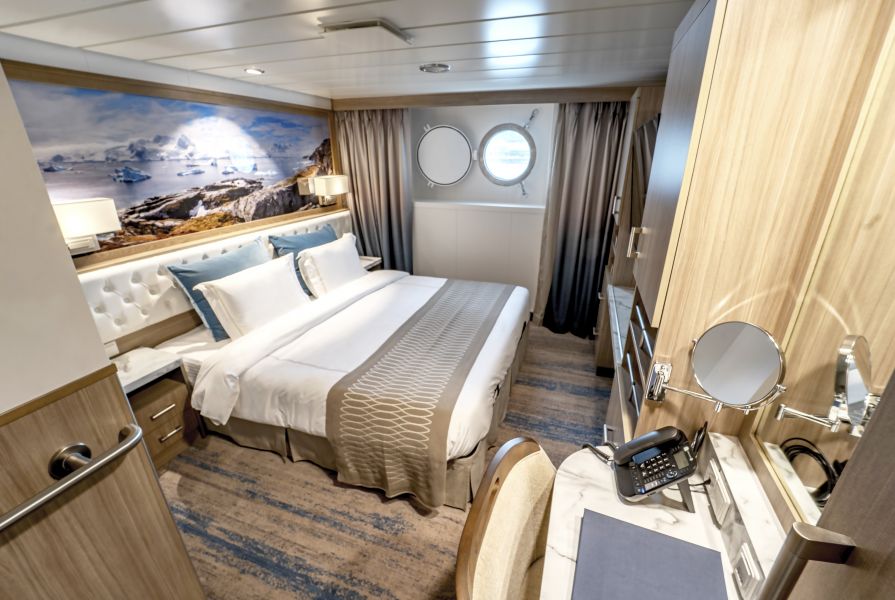
Greg Mortimer features 15 porthole rooms, all with private en-suites. Located on Deck 3, they're close to the mudroom and loading platforms, perfect for adventurers who are looking for a comfortable base that's close to the action.

There are six Aurora Stateroom Triple cabins featuring portholes, all with private en-suites. Located on Deck 3, they're close to the mudroom and loading platforms. *Please note the Aurora Stateroom Triple cabins are only available on certain departures
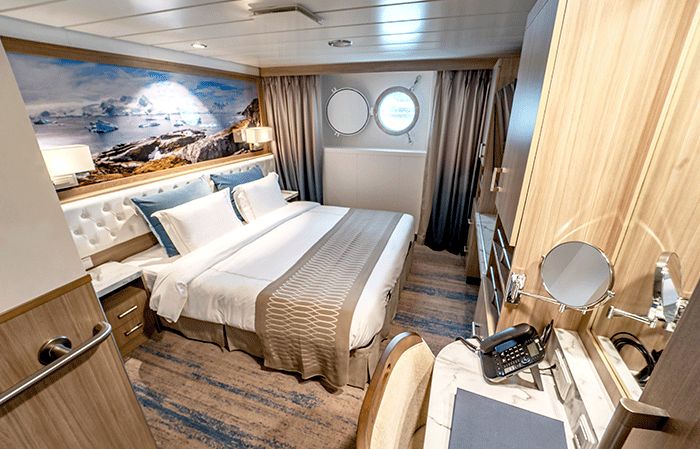
| Grade Code | From | To | |
| AS2G | Aurora Stateroom Twin | £31,156 | £31,156 |
The Greg Mortimer features eight Aurora Stateroom Twin cabins featuring portholes, all with private en-suites. Located on Deck 3, they're close to the mudroom and loading platforms, perfect for adventurers who are looking for a comfortable base that's close to the action.
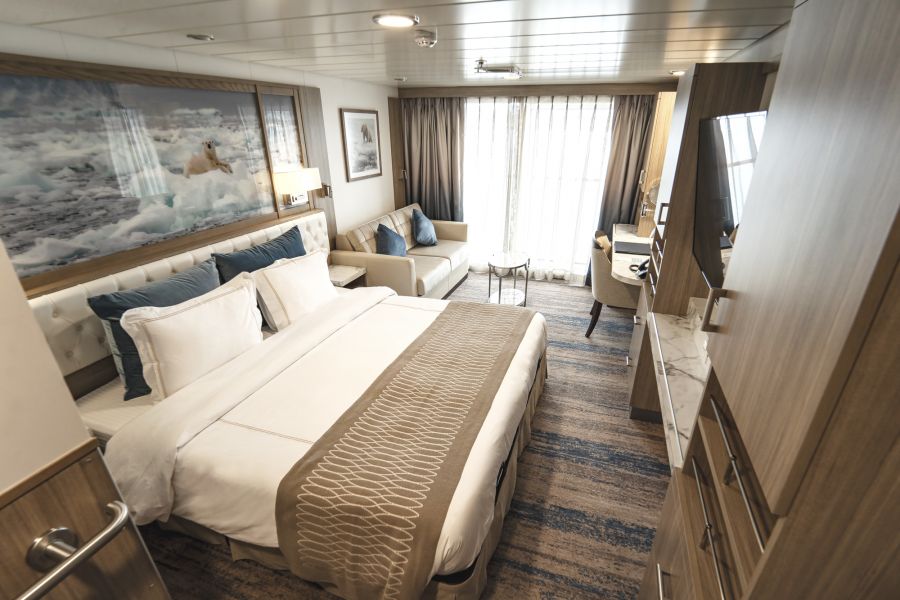
| Grade Code | From | To | |
| BSCG | Balcony Stateroom C (Forward / Aft) | £33,826 | £33,826 |
| BSBG | Balcony Stateroom B (Off Midship) | £35,607 | £35,607 |
| BSAG | Balcony Stateroom A (Midship) | £38,278 | £38,278 |
With 58 rooms available, the Greg Mortimer's Balcony Staterooms are the most abundant cabin category on board. All include en-suite bathrooms, floor to ceiling windows and balconies and a select number are also connecting rooms, perfect for families or groups.
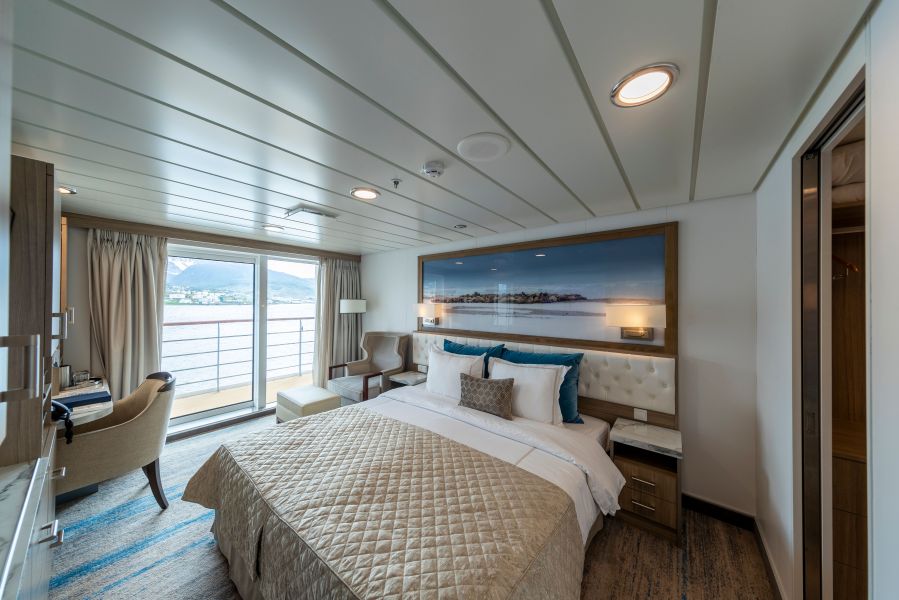
| Grade Code | From | To | |
| CSG | Captain's Suite | £62,255 | £62,255 |
The largest of all our rooms, the Greg Mortimer's singular Captain's Suite will take you to the polar regions in ultimate style and comfort. Complete with large lounge area, balcony, walk-in wardrobe and en-suite, you'll need to get in early to secure this suite.
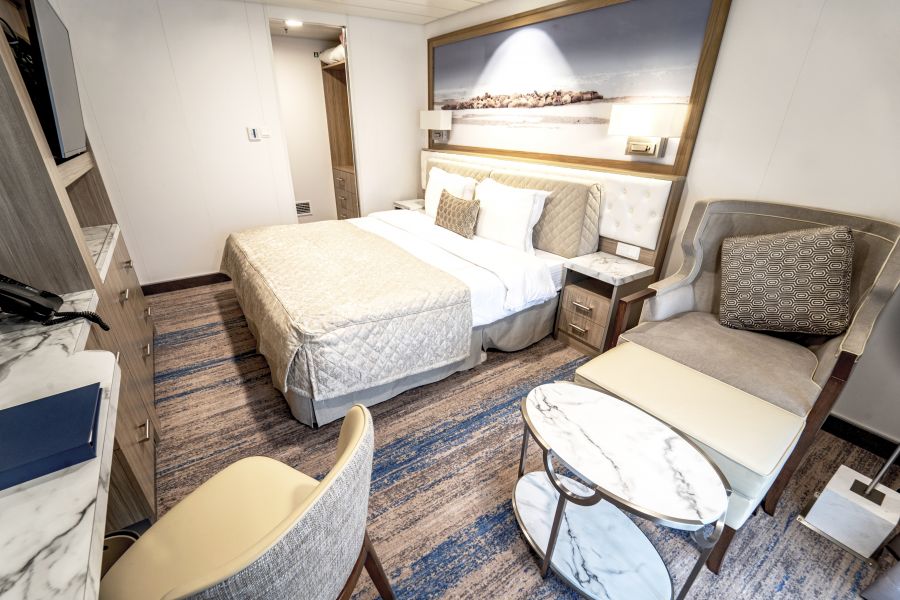
| Grade Code | From | To | |
| JSG | Junior Suite | £52,462 | £52,462 |
The Greg Mortimer's four Junior Suites take in some impressive∘ scenery from their vantage points on Deck 7. When you aren't enjoying a landing, you can relax in the suites' separate lounge area, or just watch the world float by from the private balcony.
The images shown are for illustration purposes only and may not be an exact representation of what you find on the ship.

Meals are served in a large restaurant with family style dining, perfect to swap stories with your new expedition family. Additionally, a private dining area will also be available on request. Enjoy the range of house wine, beers and soft drinks included with dinner after a long day in the wild, preparing yourself for another exciting day to follow.
On the last day of your trip, the team on the Greg Mortimer put on a special farewell four-course dinner and cocktails – a perfect way to reflect on your time on the ship and consolidate lifelong friendships with the people you've met on-board.
The images shown are for illustration purposes only and may not be an exact representation of what you find on the ship.
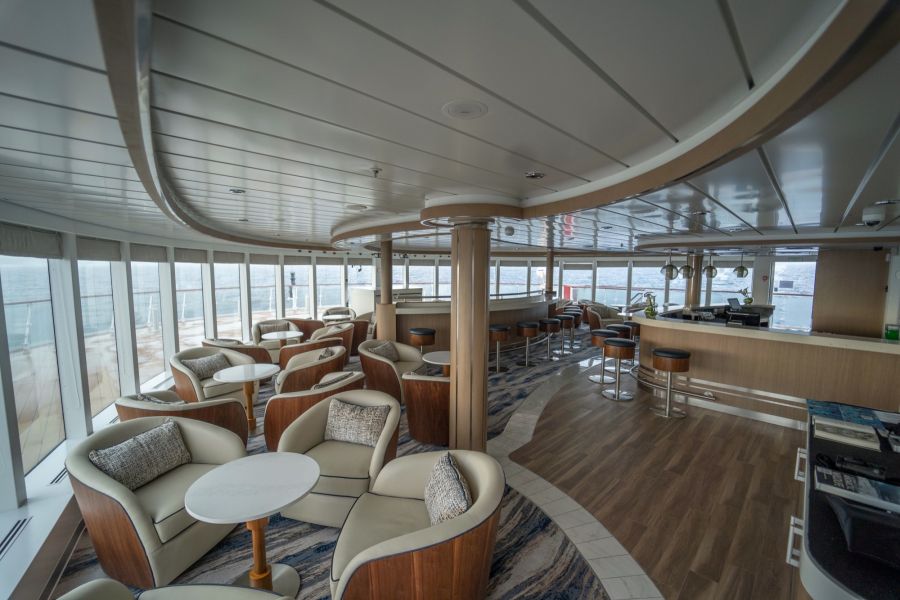
Let's face it – you don't want windowless rooms when travelling around some of the most beautiful locations around the world. This is why the Greg Mortimer is designed with plenty of dedicated observation spaces – ideal for keen bird spotters, wildlife watchers and those wanting to watch the scenery go past.
From the indoor 180-degree lounge and outdoor 360-degree open deck, both on deck 8, to the 270-degree open sundeck on level 7, there are plenty of observation points to share around the ship! If these are full, then you can take up a spot on one of the two hydraulic viewing platforms on deck 5.
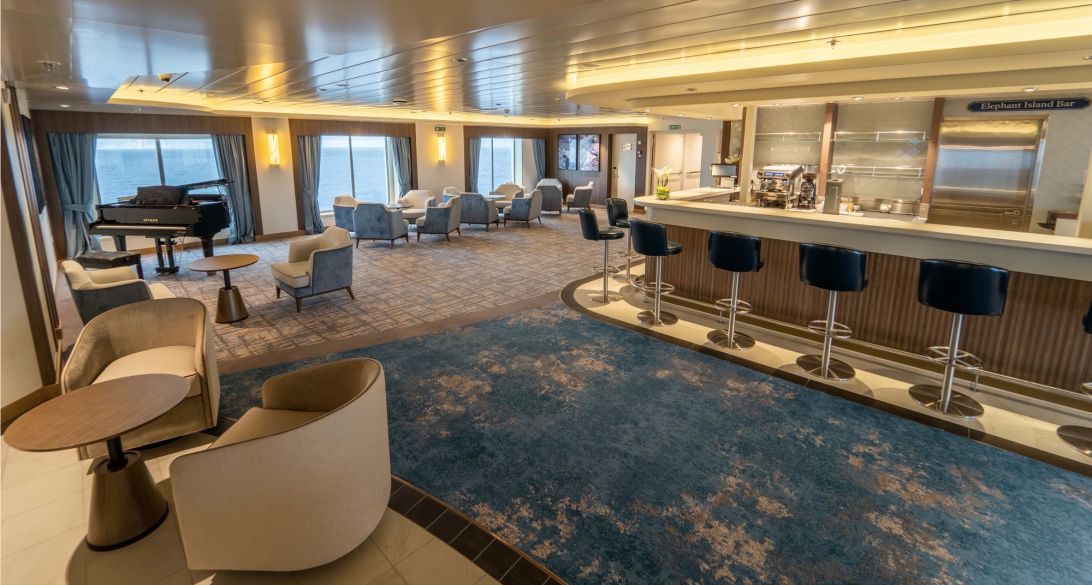
Communal meeting areas have always played a major role in fostering the warm camaraderie on board our ships. They are the heart of the expedition, where people meet to share tales from the day, swap photos, keep an eye out for wildlife and watch the sun go down.
The bars and lounges on board are refined yet inviting places to gather, with floor-to-ceiling windows offering stunning views, and of course friendly bartenders to shoot the breeze with.
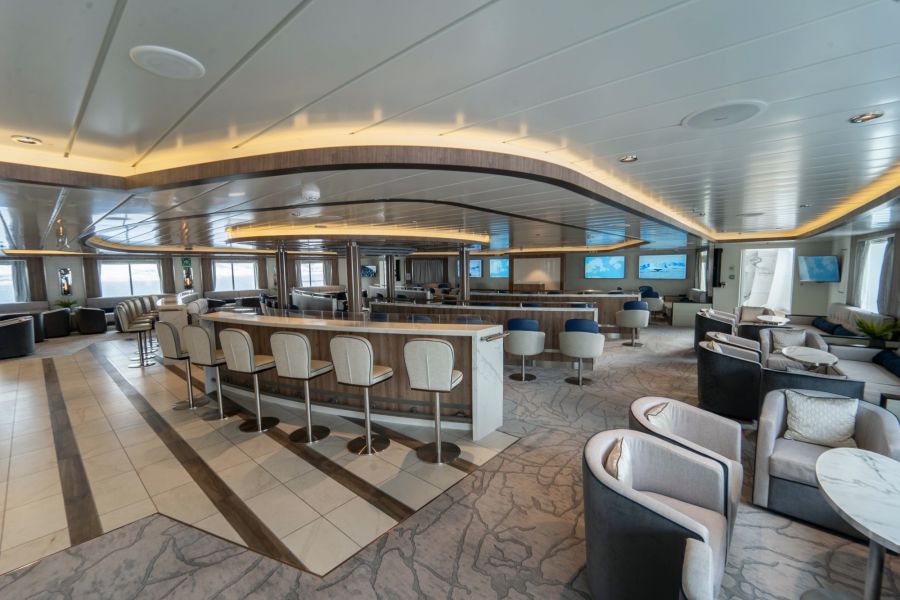
On all our expeditions, there are experts who lead presentations in the spacious lecture room so you can understand the region a little better. These often include topics as broad as history and culture to biology and climate change, these presentations aim to educate and entertain.
The images shown are for illustration purposes only and may not be an exact representation of what you find on the ship.
The images shown are for illustration purposes only and may not be an exact representation of what you find on the ship.
| 28 nights aboard the Greg Mortimer | |||
| Fully-serviced accommodation in your chosen stateroom | |||
| An informative and entertaining lecture program by our team of experts | |||
| Complimentary 3-in-1 polar jacket and the use of gumboots | |||
| Entry fees to historic or tourist sites | |||
| Daily shore excursions, guided walks, Zodiac cruises and some activities | |||
| Daily breakfast, lunch and dinner including house wines, beers and soft drinks and afternoon tea and snacks | |||
| Complimentary use of fitness centre | |||
| Comprehensive pre-departure information kit and destination resource guide | |||
| Captain’s Welcome and Farewell Cocktail Reception including four-course dinner, house cocktails, house beer and wine, non-alcoholic beverages | |||
| Complimentary access to onboard medical doctor or clinic, if required | |||
| An experienced team of destination specialists and activity leaders | |||
| Pre-dinner cocktail hour including cold canapes and bar snacks | |||
| Photographic voyage log (post-voyage) | |||
| Port Taxes and Fees | |||
 | ABTA and ATOL Protection* | ||
Date 20th Aug 2026 |
Nts 28 |
Oceanview £31,156pp |
Balcony £33,826pp |
Suite £52,462pp |
Date 20th Aug 2026 |
Nts 28 |
Oceanview £31,156pp |
Balcony £33,826pp |
Suite £52,462pp |
| Oceanview staterooms from | £31,156pp | ||
| AS2G | Aurora Stateroom Twin | £31,156pp | |
| Balcony staterooms from | £33,826pp | ||
| BSCG | Balcony Stateroom C (Forward / Aft) | £33,826pp | |
| BSBG | Balcony Stateroom B (Off Midship) | £35,607pp | |
| BSAG | Balcony Stateroom A (Midship) | £38,278pp | |
| SBSG | Superior Balcony Stateroom | £41,839pp | |
| Suite staterooms from | £52,462pp | ||
| JSG | Junior Suite | £52,462pp | |
| CSG | Captain's Suite | £62,255pp | |
Fusion Cruises when selling travel arrangements is a trading name of The Midcounties Co-operative Ltd. Fusion Cruises is an Accredited Body Member of Midcounties Co-operative Travel Consortium. (ABTA:P6652, ATOL:6053).
Book with Confidence. We are a Member of ABTA which means you have the benefit of ABTA’s assistance and Code of Conduct.
Some of the flights and flight-inclusive holidays on this website are financially protected by the ATOL scheme but ATOL protection does not apply to all holiday and travel services offered on this website. This website will provide you with information on the protection that applies in the case of each holiday and travel service offered before you make your booking. If you do not receive an ATOL Certificate then the booking will not be ATOL protected. If you do receive an ATOL Certificate but all parts of your trip are not listed on it, those parts will not be ATOL protected. Please see our booking conditions for information, or for more information about financial protection and the ATOL Certificate go to: www.caa.co.uk
